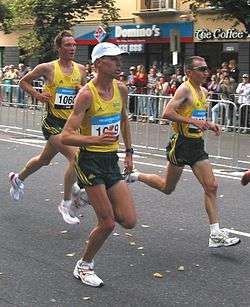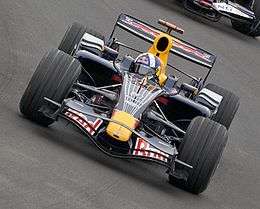Racing
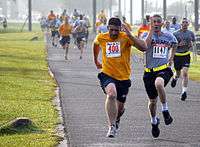

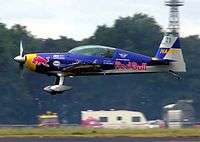
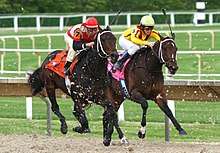
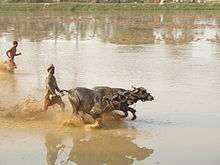
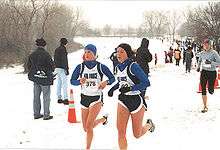
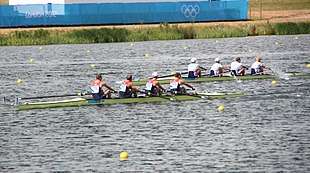
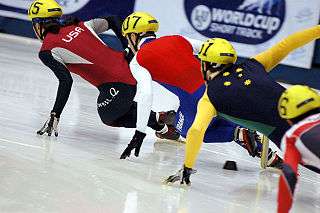
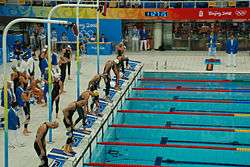
In sport, racing is a competition of speed, against an objective criterion, usually a clock or to a specific point. The competitors in a race try to complete a given task in the shortest amount of time. Typically this involves traversing some distance, but it can be any other task involving speed to reach a specific goal.
A race may be run continuously to finish or may be made of several segments called heats, stages or legs. A heat is usually run over the same course at different times. A stage is a shorter section of a much longer course or a time trial.
Early records of races are evident on pottery from ancient Greece, which depicted running men vying for first place. A chariot race is described in Homer's Iliad.
Etymology
The word race comes from a Norse word.[1] This Norse word arrived in France during the invading of Normandy and gave the word raz which means "swift water" in Brittany, as in a mill race; it can be found in "Pointe du Raz" (the most western point of France, in Brittany), and "raz-de-marée" (tsunami). The word race to mean a "contest of speed" was first recorded in the 1510s.[2]
A race and its name are often associated with the place of origin, the means of transport and the distance of the race. As a couple of examples, see the Dakar Rally or the Athens Marathon.
Forms
Running a distance is the most basic form of racing, but races may be conducted in vehicles, such as boats, cars, cycles and aircraft; or with animals such as horses or dogs. Races may also be conducted with other modes of transport such as skis, kicksled, skates or wheelchair; or other forms of movement such as swimming or walking. In a relay race members of a team take turns in racing parts of a circuit or performing a certain racing form.
Orienteering races add an additional task of using a map and compass to navigate from point to point in diverse and usually unfamiliar terrain.
A race can also involve any other type of goal like eating. A common race involving eating is a hot dog eating race, where contestants try to eat more hot dogs than the other racers.
Racing can also be done in more humoristic and entertaining ways such as the Sausage Race, the Red Bull Trolley Grand Prix and wok racing. Racing can be entertained from around the world.
Swimming
One form of racing is through swimming. There are numerous ways to perform a good swim stroke:[3] breaststroke, freestyle, butterfly and backstroke. In the racing form of swimming there are many rules that one must follow to perform fairly in a competition.
Freestyle- In freestyle the racers start off on a block start and can perform either an open turn (When the swimmer just turns in the other direction in the water on the same plane) or a flip turn (when a swimmer flips over underwater and pushes off the wall with their feet. While they do a flip turn they can only touch the wall with their feet, and at the finish with only one hand.[3]
Breaststroke- For breaststroke, all limbs must move in a similar motion at the same time, remaining underwater most of the race with the racers heads bobbing up and down for air. For every arm stroke they are only allowed one leg kick.[3]
Butterfly- Butterfly racing begins with a forward dive and after each lap, the racer must touch the wall with both hands at the same time. After the turn they must do dolphin kicks and allow their head to break the surface of the water within the first 15 meters.[3]
Backstroke- Backstroking in a race is often thought of an upside-down freestyle. These races start with the swimmers already in the water and they must maintain being on their back throughout the duration of the race. If they move their shoulders more than 90 degrees they will become disqualified from the race. [3]
Automobile Racing
There are many different types of racing in the automotive field which Include: NASCAR, street racing, drag racing, dirt bike racing, and derby cup racing. Although these are considered a type of race, they all have their own special rules and ways in which the race is performed.[4]
--NASCAR racing is a highly organized and regulated, with cars and drivers bear little resemblance to anything you would find on any back road or the city. NASCAR is rated number 2 as the most watched sport on T.V. This is so popular due to the ability of the drivers. This brings high amounts of thrill to people by showing that the drivers are fearless as they travel 200+ mph on a circle track.[4]
--Street racing is illegal in many countries and territories. The participants are often teenagers. A street race involves two or more people informally meeting on a road, which can vary in size and quality, then racing together. There are “pink slips” which are found in formal, better organised street races that contain prizes for winning. These result in a potential loss of ownership over a car; if a participant wins, they gain the vehicle of the opponent, whereas the reverse holds true. There are no real rules involved in street car racing other than to honor what you bet upon between drivers participating.[4]
--Drag racing is exactly like street racing other than it is done by professionals and is closely monitored, always stored with an ambulance and medics on spot. These races are meant to see who can cross the finish line first, but before each race each driver is allowed and recommended to perform a burn out in order to heat up the tires to obtain more friction on the road. The drivers then line up, wait for the light to turn green, green, green, then they are off. Typically, a 1/4-mile race is run and depending on the type of car or how fast they are that’s how they determine the bets on who will win and who will lose.[4]
Speed Skating
Speed skating is performed on an ice rink and is usually done through the Olympics or other large organizations that perform in winter sports such as this. There are a lot of factors that go into having a fair, proper and safe ice race.[5]
--The Draw happens before any race and take place there needs to be a qualifying round, or the draw, to determine the place in which the racers will start in for their desired heat.[5]
--Before the Start of the race, the racers’ names are called and they must appear to the starting line within the given time or they will not be allowed to race. Once at the starting line, they must approach the line saying “ready” but at no point touch the line with their skate or with any other body part until the gun is shot.[5]
--False Starting for the race happens If the racer takes the starting line before saying ready or if they leave the starting line before the gun has been fired, they will receive a false start. They are given a warning at first and if they false start again then the racer whose fault it was will be disqualified from the race.[5]
Crossovers- During the race, each racer must switch lanes one time during each lap. This is due to the inner lop being shorter than the outer loop so it is only fair to have the racers switch each lap. Skaters can be disqualified for cutting the lines or leaving the inner curve.
Cutting lines- When the racer is making the turn they must not cross the inner line as they will be cutting the loop shorter, even though it is not that much of a distance, it will still differ on the racers finishing times.
--When Leaving the inner curve, if for some reason the racer cannot hold the inner curve and for some reason interferes with the other racer, he or she will be disqualified.
-- At the Finish, when they are approaching the finish line, the only way to complete the race is when the tip of their skate crosses the finish line. If they fall short and slide through the finish, time will not be recorded until the tip of the skate is through the finish line.[5]
Sprint finishes
A sprint finish is a racing tactic used in many forms of racing where a competitor accelerates towards top speed in the final stages of a race. This tactic is mostly associated with long-distance forms of running and cycling, which often feature large groups of competitors racing at a slower pace for much of the race – this slower aerobic racing allows for the subsequent anaerobic activity required for sprinting.[6] The tactic relies upon keeping greater energy reserves than your opponent until the last part of the race in order to be able to reach the finish point first. It is the opposing tactic to keeping a steady optimal pace throughout a race to maximise your energy efficiency (see running economy).[7]
In track and field, distances from 1500 metres upwards often feature sprint finishes. They can also be found in cross country and road running events, even up to the marathon distance. A runner's ability to sprint at the end of a race is also known as their finishing kick.[8] Multisport races, such as the triathlon, often have running as the final section and sprint finish tactics are applied as they are in running-only events.[9]
In cycling, sprint finishes are an integral part of the sport and are used in both track cycling and road cycling. Cycling sprints are often highly tactical, particularly on the track, with cyclists occasionally coming to a near halt at points before reaching a high speed finish.[10] The longer track races such as scratch races often feature sprint finishes, as maintaining a steady pace within the peloton allows opponents to conserve energy through drafting.[11] Road races are similar in this respect, in both short criterium races and long-distance races. Sprint tactics also form a major part of points classifications in road events, where cycling sprinters specialise in reaching an intermediate point first, thus gaining extra points and resulting prizes.[12][13]
Sprint finish tactics are also used in speedskating, cross-country skiing, long-distance swimming,[14] horse racing and other animal racing sports.[15][16] The finishes of races which are outright sprinting events in themselves, such as the 100 metres track race, are not normally referred to as sprint finishes, as all competitors are already sprinting by default (thus it is not a racing tactic).
See also
References
- ↑ "Online Etymology Dictionary". Online Etymology Dictionary. Retrieved 28 June 2010.
- ↑ "Race". Online Etymology Dictionary. Retrieved July 13, 2012.
- 1 2 3 4 5 "Swimming Rules & Regulations". SwimOutlet.com. Retrieved 2018-04-11.
- 1 2 3 4 "2018 rules updates: 'Stabilization mode' entering new season | NASCAR.com". Official Site Of NASCAR. 2018-02-01. Retrieved 2018-04-29.
- 1 2 3 4 5 "Olympics 2018". NBC Olympics. Retrieved 2018-04-29.
- ↑ Ronald J Maughan, & Michael Gleeson (20 May 2010). "Energy Supply". The Biochemical Basis of Sports Performance (pg. 129). Oxford University Press. ISBN 9780199208289
- ↑ Stevenson, Roy. Developing a fast finish for your road races. Multi Briefs. Retrieved on 2014-04-17.
- ↑ Fitzgerald, Matt (2013-11-18). Kick Your Way To Better Race Times. Competitor. Retrieved on 2014-04-17.
- ↑ Stevenson, Roy (2013-07-13). Developing a fast finish. Triathlon & Multisport Magazine. Retrieved on 2014-04-17.
- ↑ The individual sprint . BBC Sport. Retrieved on 2014-04-17.
- ↑ Scratch Race. Cycling Calendar. Retrieved on 2014-04-17.
- ↑ Gitz, Jarred (2014-04-05). The Points Classification . Jareds Cycling. Retrieved on 2014-04-17.
- ↑ Smith, Mark (2008-05-01). Technique: Sprint finishing. Bike Radar. Retrieved on 2014-04-17.
- ↑ Open Water Swimming. Masters Swimming. Retrieved on 2014-04-17.
- ↑ Minella best in sprint finish. British Horse Racing Authority. Retrieved on 2014-04-17.
- ↑ James, Dave (2014-02-24). Matt breaks record as doping hits Sochi. China Post/Agence France Presse. Retrieved on 2014-04-17.
External links
| Look up racing in Wiktionary, the free dictionary. |
